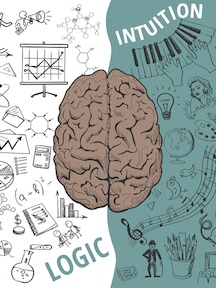By Cheyanne Cierpial
People are often categorized as left or right-brained. In an educational setting, this implies that each student belongs to either the math/science or the humanities/art sides of education. In the liberal arts, however, no such either/or limitation is placed on students.
An English professor elaborates on astrophysics to make sense of a poem, while a biologist performs her creative writing at a public reading. A chemistry major excels in a gender studies course. A studio art major uses his talents to create a dialogue on international issues. Students play a role in actively shaping their education, tailoring it to their interests and passions. They embody the breadth and depth of interdisciplinary learning through a myriad of major, minor, and concentration combinations.
Allegheny College, for one, boasts that its students embrace “unusual combinations” as the model of their education, and for good reasons. According to Kathy Roos, writing for Allegheny Magazine: “The evidence is that a liberal arts education…is a more effective means of reaching career goals, especially in a world where jobs often evolve beyond our ability to predict what skills we’ll need to fill them. Diversity—of interests, skills, and talents—is the key.”
Interesting combinations of majors, minors, and concentrations allow students to pursue a range of passions and interests, while drawing on the interdisciplinary connections of the liberal arts. Maya Muenzer, for example, is a biology and dance double major at Oberlin College. She combines her love for dance with her fascination with the human body.
“Last year I was really able to build a bridge between my two majors because in a biology seminar I was taking we had to do an education outreach project,” Muenzer said. “For this project, I constructed a presentation called ‘The biological basis of injury and healing for dancers,’ which I later presented to the dance department.”
“I found that many people involved in the dance department were very interested in understanding what is physiologically happening in their bodies, and I felt that I had the platform to help them understand this with my background in biology,” Muenzer explained.
Exposure to other departments allows students to think both creatively and critically, providing a new lens through which to view other disciplines. Anna Damato, a neuroscience major and environmental science minor at The College of Wooster, has used her study in two scientific fields to understand mankind’s relationship to the environment.
“I can best explain how a neuroscience/environmental studies combination embodies a liberal arts education with an example: Environmental contaminants start and end with humans,” Damato said. “We produce them, and they can really damage us—just look at Flint, Michigan.”
Damato continued: “To detect contaminants and change manufacturing processes, you really need chemists and biologists; to change regulations pertaining to industrial waste or wastewater treatment, you need policy makers [and] political scientists; to understand the human relationship with waste and the environment, you need philosophers, religion experts, and psychologists.”
“Only a liberal arts education can give you a bit of all of these perspectives,” Damato said.
The ability to gather different perspectives and relate them to one another is what Trey Duncan, a music and physics double major at Furman University, believes leads to innovation and discovery.
“It wasn’t my original plan, but the more I study both [music and physics] the more I become interested in the overlap between the two fields… So often we try to place aspects of life in a bubble,” Duncan said. “Object A goes here and object B goes there, but some of the most important work we can do is realizing the relationships between different fields.”
“That’s where the breakthrough discoveries come from, and if you only ever study what every person in that field has studied before them, what new information do you bring to the table?” Duncan observed.
For those not familiar with the liberal arts, these students’ choices may be unheard of or seem peculiar. At many liberal arts institutions, however, double majoring or minoring in unrelated fields is encouraged and normalized.
“At Muhlenberg, my combination of majors isn’t seen as ‘odd’ at all,” explained Loren Sass, a double major in dance and business at Muhlenberg University. “In fact, many of my fellow dance majors are either getting a second major or minor in business.”
“It may seem ‘odd’ at other institutions or conservatories, but I want to prepare myself to enter the dance world from many angles, and I think combining these majors will hopefully pave my way,” Sass explained.
Whether it’s creative writing and chemistry, art history and political science, or physics and international studies, the liberal arts encourages curiosity, exploration, and life-long learning both in and beyond the classroom.
Cheyanne Cierpial is a senior at Denison University majoring in English literature and minoring in psychology. Denison University is home to the Theta of Ohio Chapter of Phi Beta Kappa.




